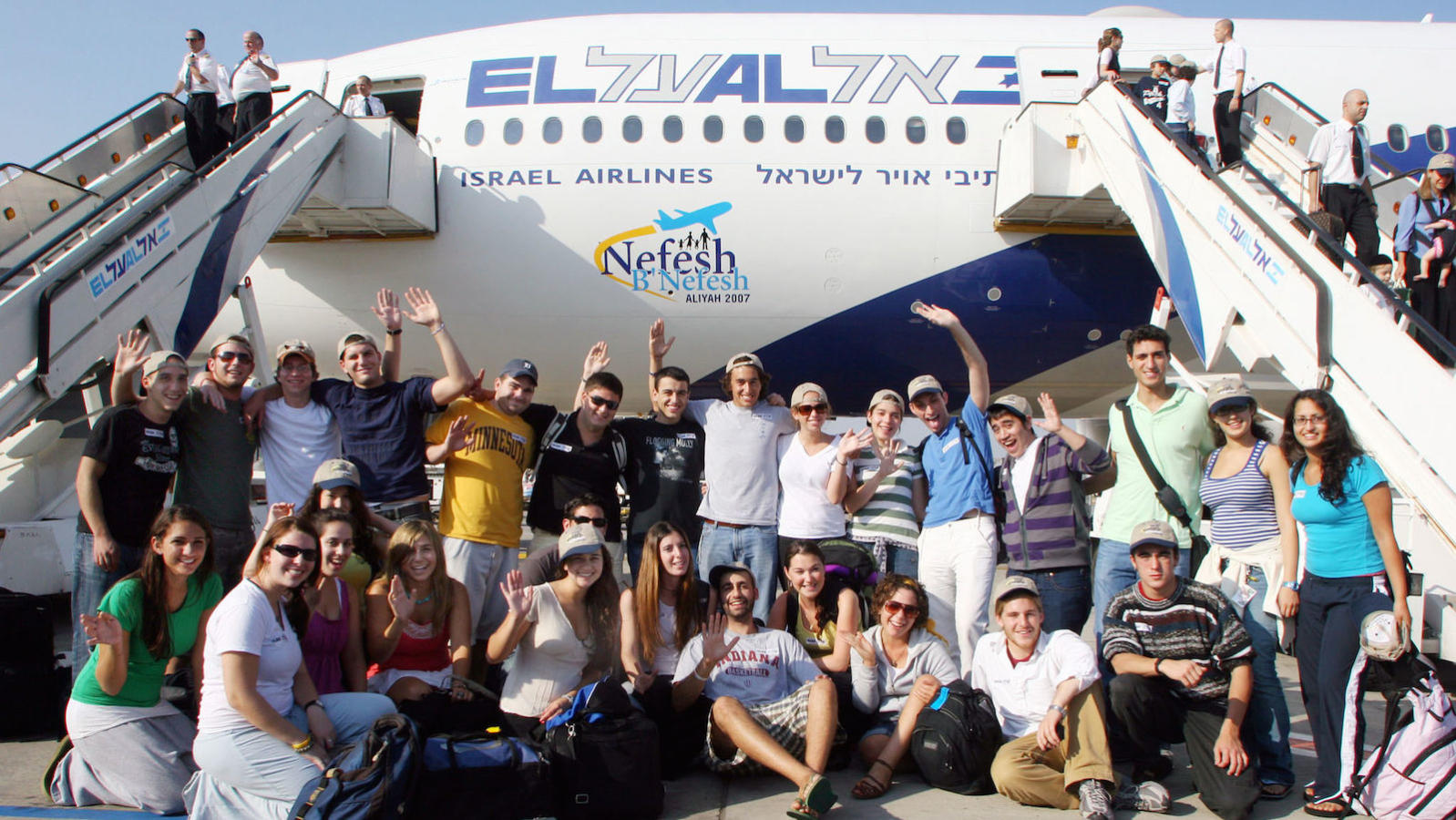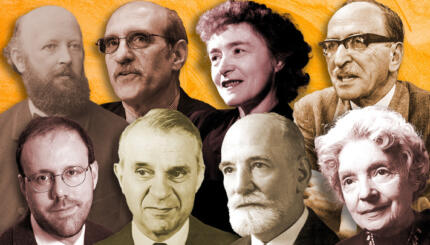Hebrew for “ascent,” is the term for Jewish immigration to Israel. (It also means to be called to the bima to say a blessing before the Torah reading.)
Five Aliyah Snapshots
From the United States
Joel and Debbie Wine and their three young children left Massachusetts for Israel in July 2006, despite the ongoing war between Israel and Hezbollah. According to Joel, “This is Israel, and if you think of yourself as Israeli, you realize there’s really not a choice. We’ve mentally, psychologically, emotionally made the commitment to be part of the people of Israel in the Land of Israel, and unfortunately, this [war] is part of the reality.” Debbie: “We’re hoping that [our children] will look to Israeli soldiers as heroes rather than the commercial superheroes and princesses that seem to dominate American children’s media.”(www.haaretz.com)
From Russia
Andrew Goldis (21) grew up in the town of Zheleznogorsk, Russia. His father is Jewish but his only connection to his roots was the fact that he was teased at school for his Jewish appearance. On a visit to Israel at the age of 14, Andrew was impressed by the country’s beauty and spirituality. He decided to sign up to the Na’aleh program in which teens from the former Soviet Union complete high school in Israel. “I was living on my own, learning in a new and exciting place and meeting great people,”says Andrew. “Once in Israel, I felt that I wasn’t different anymore.”(www.jewishagency.org)
From Argentina
Ariela Hurvitz made aliyah from Argentina. She was curious about Israel, her parents having lived there when they were first married. Ariela’s grandparents had migrated from Europe to South America, and her own family had also moved around. “My family had a long journey. They were like wandering Jews. By contrast, I feel Israel is my place in the world. In Israel, I’m Jewish and feel like I’m planting roots.”(www.jewishagency.org)

Help us keep Jewish knowledge accessible to millions of people around the world.
Your donation to My Jewish Learning fuels endless journeys of Jewish discovery. With your help, My Jewish Learning can continue to provide nonstop opportunities for learning, connection and growth.
From Ethiopia
Yosef Adhina, 23, a business student from Addis Ababa, made aliyah to join his father who had left Ethiopia for Israel in the 1980s. “I felt that I also wanted to come to Israel and to live there as a Jew … Life was hard in Ethiopia. There were no opportunities and lots of financial worries. Here it’s better. But the best thing is to be able to talk the holy language, to feel at home as a Jew.” (www.jewishagency.org)
From France
Julien Daham, 29, made aliyah in 2006 from Nice, France. Israel is the place he feels most at home, despite the threat of Kassam and Katyusha missile attacks. “I don’t feel unsafe here,” he said, describing France as more dangerous than Israel. “The streets are safer here, even with all the attacks.” (www.jpost.com) Dafne Partouche, 18, also from France, says I’m not afraid of Hezbollah … I trust the Israeli army. They will not let Hezbollah destroy the country. Well, maybe I’m a little afraid.” (www.jta.org)
In a 2006 open letter to new immigrants, Jewish Agency Chairman Ze’ev Bielsky wrote that “the decision to make aliyah is a complicated personal decision. However, in these times it takes on a special meaning of national importance… The best answer to terrorism is not military but in aliyah to Israel.” But — as evidenced by the five snapshots — Bielsky’s heroic, ideological conception of aliyah only goes so far in explaining the decision to move to Israel.
Aliyah in the 21st Century
In 2010, over 19,000 people made aliyah, up from 16,465 the year before. The biggest group of olim or immigrants — 40 percent of the total — came from the former Soviet Union, Eastern Europe, and Germany. 1,650 olim were Ethiopians. France supplied 2,040 immigrants, while North Americans accounted for 3,980 arrivals. 1,470 South Americans made aliyah in 2010, including 380 Argentineans. 760 olim made their way from Britain, and 260 arrived from Australia and New Zealand.
While these figures seem impressive — especially in light of Israel’s precarious security situation — they pale alongside statistics from earlier years.
For the latest statistics on immigration to Israel (and other aspects of Israeli life), visit the website of Israel’s Central Bureau of Statistics, which publishes an annual data abstract (available in English, as well as Hebrew) each year.
During the 1980s, immigration to Israel had averaged just over 15,000 a year. Then in 1990, following the collapse of Communism in the Soviet Union, this figure jumped to 199,516, dropping only slightly to 176,100 in 1991. During the ’90s, Israel absorbed an average of 95,000 immigrants every year.
Push and Pull Factors
Israel’s volatile aliyah rate fluctuates in response to push and pull factors. The 1990s post-Soviet olim initially responded to glasnost and the lifting of travel restrictions for Russian Jews, but were ultimately propelled out of the former USSR by political instability–accompanied by the rise of anti-Semitic ultra-nationalism–and economic collapse. In the 1990’s, Israel was an attractive destination: it was coasting on a high-tech boom and, after the Oslo accords, enjoying what it hoped were the first glimmerings of peace with the Palestinians. Some immigrants saw Israel as a convenient staging post before traveling on to their final destination: America. Yet the early waves of post-Soviet aliyah were also characterized by Jewish involvement and a desire to become part of Israeli society.
Parallel to the immigration wave from the former Soviet Union was a much smaller aliyah from Ethiopia. In Operation Moses (1984), 8,000 Ethiopian Jews crossed the Sudanese desert on foot before being secretly airlifted to Israel. Six years later, in 1991, most remaining members of the Ethiopian community–about 14,000–were transported to Israel over one weekend in the course of Operation Solomon. The Ethiopians were motivated by the need to escape from famine and civil war, but also by their belief in the biblical prophecies of the Israelites’ return to Jerusalem.
The Argentinean aliyah at the beginning of the 21st century was prompted by that country’s economic collapse. Argentinean Jews were fleeing unemployment and the threat of hunger. In 2002, 5,931 Argentineans made aliyah. As the crisis subsided, emigration to Israel dropped off: to 1,473 in 2003 and only 458 in 2004.
Jews who decided to leave France for Israel since 2000 had a different motivation: the eruption of anti-Israel and anti-Semitic hostilities, including violent attacks on members of the community.
Like many Soviet and Ethiopian olim, the French and Argentinean Jews who left their homes for Israel tended to display one other important characteristic: a high level of communal affiliation and a strong Jewish identity. This trait is nowhere more dominant than among olim from the English speaking world–primarily the US, Canada and Britain–countries which have better economic prospects and have no recent history of significant anti-Semitism. These olim hope to find religious fulfillment, plan to immerse themselves in a majority Jewish culture, or aspire to play a role in strengthening the Jewish state. It’s no coincidence that Western aliyah peaked during Israel’s brief, euphoric period of pride and self-confidence in the aftermath of the 1967 Six Day War.
But even in the West, economics has a role to play. The mission of the Nefesh b’Nefesh organization, founded in 2002, is to “substantially increase the number of future [North American] olim by removing the financial, professional and logistical obstacles that prevent many individuals from actualizing their dreams.” Nefesh b’Nefesh propels new immigrants through the maze of government bureaucracy and provides significant financial support to tide olim through their initial period in Israel. In its first five years, the organization brought over 6,500 Jews to Israel, and by 2011, the organization had brought over 26,000 olim. The “Great Recession” beginning in the US in 2007 also led to a dramatic increase in North American aliyah. The implication is clear: however strong the ideological commitment to aliyah, money is necessary to catalyze the process.
Idealism or Pragmatism?
This insight runs counter to idea of aliyah in much classical Zionist thought. Early 20th-century thinkers such as Ahad Ha’am and A. D. Gordon believed that Diaspora life had a fossilizing, corrupting effect on the Jewish people’s psyche. Aliyah meant shaking off the dust of Exile and returning to the Land as upright, independent Jews, to participate in the creation of a modern, dynamic Hebrew culture. As recently as 2005, then Prime Minister Ariel Sharon surprised no one when he addressed Jewish visitors from all over the world at the opening of the Maccabiah Games: “I hope that by the next Maccabiah, you will have immigrated here and be part of the Israeli delegation.”
Yet Theodor Herzl‘s predictions of mass immigration to the Jewish state as a result of economic distress and anti-Semitism — and not ideology –have proved more accurate. Throughout Zionist history, waves of immigration have stemmed from Russian pogroms in the 1880s, Polish and Nazi antisemitism in the 1930s, hostility in the Middle-East and North Africa in the 1940s and ’50s, and economic and political strife in 21st century Russia, Ethiopia and Argentina.
Whether aliyah is driven by idealism or pragmatic considerations, it seems clear that the opposite phenomenon–yeridah or emigration from Israel–is motivated primarily by economics and the dubious security situation. Between 1996 and 2002, the net gain to Israel’s population as the result of migration (the number of olim minus the number of yordim, or emigrants) fluctuated between 12,000 and 50,000. In 2003 and 2004, the balance flipped — over two years, Israel experienced a negative balance of Jewish emigration, losing over 20,000 people to the Diaspora.
All statistics taken from the Central Bureau of Statistics (www.cbs.gov.il) and the Ministry of Immigrant Absorption (www.moia.gov.il).



